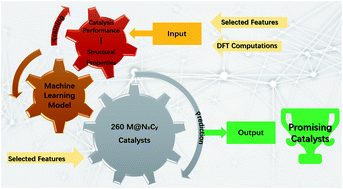Directly predicting limiting potentials from easily obtainable physical properties of graphene-supported single-atom electrocatalysts by machine learning†
Abstract
The oxygen reduction reaction (ORR), oxygen evolution reaction (OER), and hydrogen evolution reaction (HER) are three critical reactions for energy-related applications, such as water electrolyzers and metal–air batteries. Graphene-supported single-atom catalysts (SACs) have been widely explored; however, either experiments or density functional theory (DFT) computations cannot screen catalysts at high speed. Herein, based on DFT computations of 104 graphene-supported SACs (M@C3, M@C4, M@pyridine-N4, and M@pyrrole-N4), we built machine learning (ML) models to describe the underlying pattern of easily obtainable physical properties and limiting potentials (mean square errors = 0.027/0.021/0.035 V for the ORR/OER/HER, respectively) and employed these models to predict the catalytic performance of 260 other graphene-supported SACs containing metal-NxCy active sites (M@NxCy). We recomputed the top catalysts recommended by ML towards the ORR/OER/HER by DFT, which confirmed the reliability of our ML model, and identified two OER catalysts (Ir@pyridine-N3C1 and Ir@pyridine-N2C2) outperforming noble metal oxides, RuO2 and IrO2. The ML models quantitatively unveiled the significance of various descriptors and quickly narrowed down the candidate list of graphene-supported single-atom catalysts. This approach can be easily used to screen and design other SACs and significantly accelerate the catalyst design for many other important reactions.

- This article is part of the themed collection: Editor’s Choice: Machine Learning for Materials Innovation


 Please wait while we load your content...
Please wait while we load your content...
